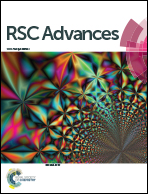Catalytic role of iron-superoxide dismutase in hydrogen abstraction by super oxide radical anion from ascorbic acid†
Abstract
The catalytic role of iron-superoxide dismutase (Fe-SOD) in the work of ascorbic acid (AA) as a superoxide radical anion scavenger has been studied by employing a model developed recently for the active site of the enzyme. All relevant molecular geometries were optimized at the M06-2X/6-311+G(d) level of density functional theory in the gas phase, which was followed by solvation in aqueous media, employing the integral equation formalism of the polarizable continuum model (IEF-PCM). It was found that single step double hydrogen transfer from each of four pairs of AA sites, and two separate single hydrogen transfers from each of two pairs of AA sites, are involved in scavenging the superoxide radical anions. Even in the absence of Fe-SOD, AA is shown to serve as a fairly good superoxide radical anion scavenger, in agreement with experiment; however, in the presence of Fe-SOD, its efficiency is highly enhanced as double hydrogen transfer from three pairs of sites of AA becomes barrierless. The barrier energy for the first step of the single hydrogen transfer from each of the two pairs of AA sites is very high, due to which this mechanism would practically be inoperative. Further, transformation of H2O2 into two water molecules, due to its dissociation into two OH radicals, followed by transfer of two hydrogen atoms from AA, with the process not involving Fe-SOD, would also not occur practically, as the corresponding barrier energies are very high. Thus, AA would not be able to scavenge H2O2.


 Please wait while we load your content...
Please wait while we load your content...